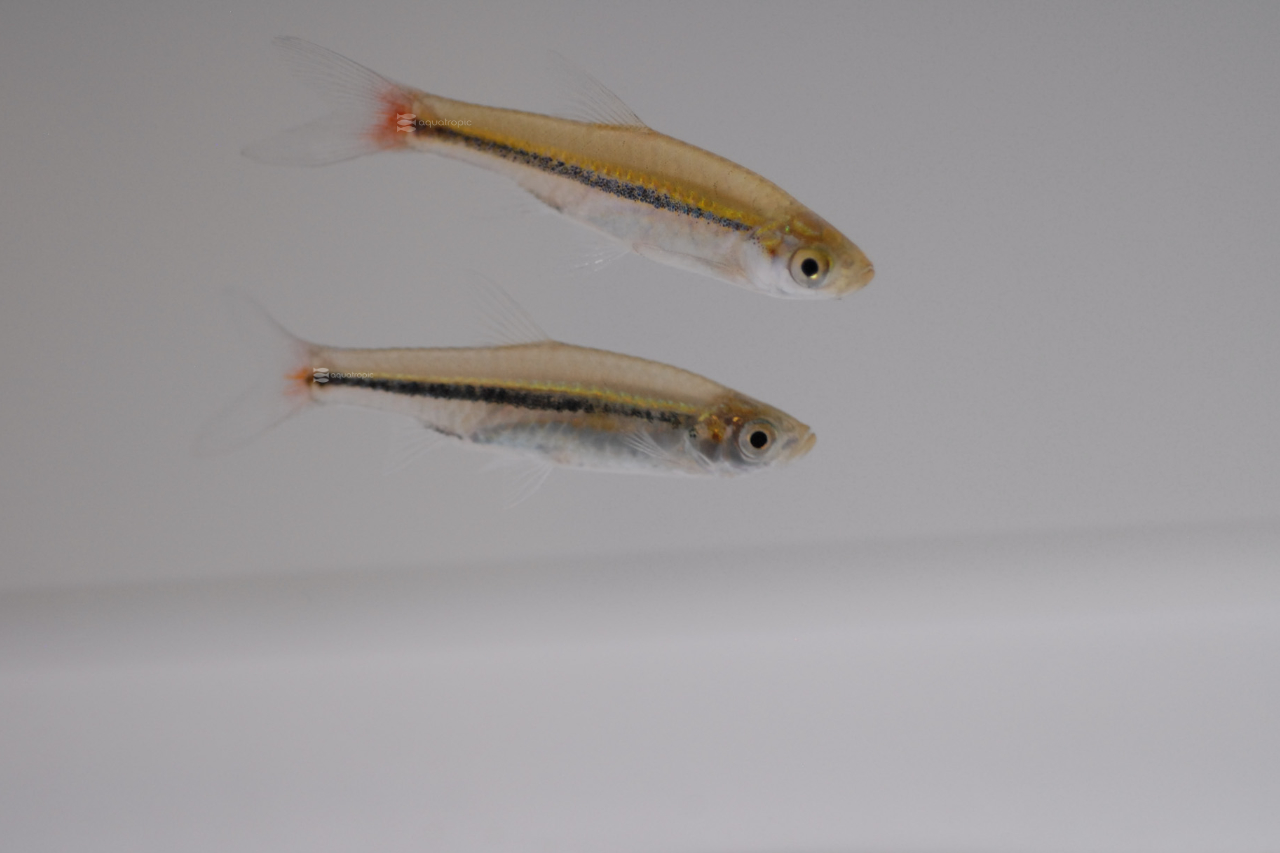Basking in Brilliants

The Brilliant Rasbora is just that, brilliant. This shows best in their coloration, with pale backs, red tails and striking black and shimmering gold lines down their sides. They are also brilliant in their ease of care, outstanding hardiness and adaptability to a variety of freshwater displays. They are schooling fish that get three or four inches long, making them excellent dither fish for larger displays.
The scientific nomenclature for the Brilliant Rasbora is Rasbora borapetensis. Rasbora is an Indian word for fish and is the widely assumed origin for the Genus name. As of the writing of this we could find no good translation or justification for the species name, though a very loose translation from Latin would be “pet knife.” In regard to common names, they have a few, most often they are called Brilliant Rasbora, but less commonly they also get tagged as Black Line Rasbora, Red Tail Rasbora, Borapet Rasbora and close translations of all these.
While this fish is more common in the Mekong Delta and across the Malay Peninsula, it can also be found in

mainland China, India and parts of Indonesia and Malaysia. Some of these locations outside of Thailand, Vietnam and Cambodia may not be native habitats for this species. The Brilliant Rasbora's wild environment is extremely varied, and they can be found everywhere from the clear, free flowing feeders of larger rivers to the edges of medium sized streams to perennially stained, and nearly flow-less floodplains, drainage ditches and canals, even some that have chronic pollution issues. Some unifying characteristics are that they are always found in groups and that they are generally in quite shallow water (less than a couple feet deep) with a preference for fairly dense cover; both of these conditions should be emulated in your display.
Brilliant Rasboras should always be kept in as large a group as you can fit in your aquarium, and we suggest a bare minimum of seven. Groups of 15-20 will show better color, activity and be more healthy than smaller groups. As such, a minimum display size for a group of seven would be 40 gallons, with an emphasis on wider footprint over depth when choosing dimensions. Larger groups would obviously need larger tanks. While this fish can do very well in fairly high flow, brightly lit displays, it does not require either and thus both are somewhat irrelevant characteristics for successful husbandry.
The best displays for Brilliant Rasboras will be densely decorated, whether this is with driftwood, leaves and rocks, or a variety of plants isn't really relevant. They seem to do best, and show their best colors over dark substrates, dark backgrounds and a lot of cover. They are popular in stained water aquariums and are a good fit for such as many of their native habitats look this way naturally. Many displays utilize surface cover and plants to make lighting more subdued.
Water chemistry is easy, as the vast majority of the Brilliant Rasboras being sold today are aquacultured and have been so for hundreds, if not thousands, of generations. This has been going on for long enough, successfully enough, so that wild specimens have become very rare to see in aquariums, even though wild populations are robust. These fish are extremely hardy and durable and will thrive in aquarium parameters that are acceptable to other tropical fish. For those of you looking for an ideal, they seem to do best in water that is neutral to slightly acidic, pH 6-7, and water that is on the softer end of the scale, under 20 degrees of hardness or so. Water temperatures should be pretty normal for a tropical aquarium, between 72- and 78-degrees Fahrenheit.
As one would expect with any aquacultured fish, Brilliant Rasboras are raised on processed foods and are already eating small pellets. In house we feed them Nutramar Freshwater Complete pellets twice a day. This is an excellent diet for them, and they perform very well, but we also supplement this with some thawed foods from Gamma. Foods like Artemia (Brine), Daphnia, Tubifex and Mysis are all greedily mowed down. Live versions of all these foods are also a great treat.
For those of interested in breeding Brilliants, this live food or additional meaty food can help bring your fish into spawning condition. When trying to differentiate the sexes, males will be smaller, slimmer and slightly more brilliant. If you are keeping a well dialed in tank, it's totally possible that baby fish will just start appearing. If you actually want to have a high rate of success, you'll need to get adults away from the eggs that they scatter, or the eggs will get eaten. This is most often done by using a mesh over the bottom of the tank so that the eggs can fall through, and the adults can be removed. Depending on the temperature of your display, the eggs should hatch in a day or two and be free swimming a day or two after that. Baby Brilliant Rasboras will need very small food like infusoria, and later brine shrimp nauplii and microworms. We have articles on this website about raising all these kinds of food.
Brilliant Rasboras are staff favorites for many reasons: their coloration, their activity, their incredible hardiness to name a few. If you have a big display and want a larger-than-tetra dither fish, there is no better choice than a big batch of Brilliants. Even in slightly smaller tanks, a group of these will add an excellent level of activity, bring out other fish and a be a complement to other small groups of fish. If this is your thing, head to your LFS and ask them about getting you some Brilliant Rasboras from Aquatropic today!